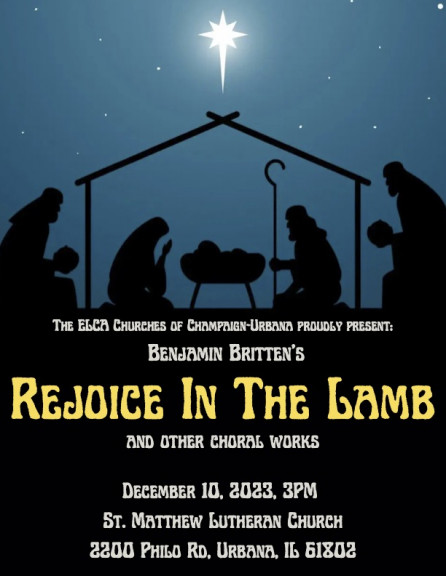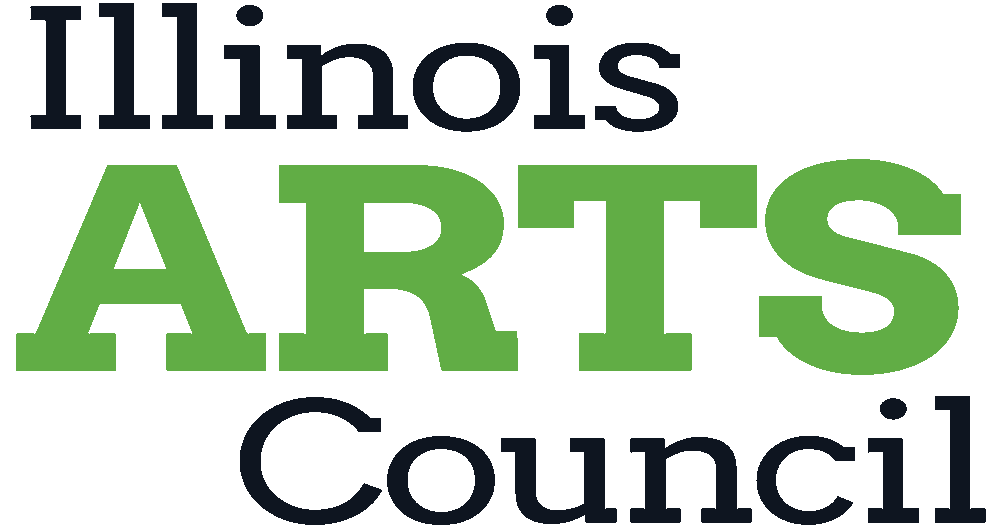Advent Cantata with ELCA Choirs

Central Illinois has a longstanding reputation as a hub for choral excellence thanks to the influx of talent from the University of Illinois School of Music. In fact, two UIUC alums just scored 2024 Grammy nominations for Best Choral Performance: Donald Nally (DMA ’95), director of The Crossing, for Carols After A Plague, and Craig Hella Johnson (MM ’85), director of Conspirare, for The House Of Belonging. Area churches are often the beneficiaries of this conducting talent as graduate students take up music director positions during their studies. We met with one such student to learn about an exciting musical project he is leading this holiday season.

Conductor Nicholas Pierle
A native of Waxhaw, NC, conductor Nicholas Pierle directs the music ministry at Grace Lutheran Church and is currently a first-year DMA Choral Music student at the University of Illinois. Prior to moving to Champaign, Pierle worked as an Adjunct Professor of Music at Queens University of Charlotte, where he taught courses in undergraduate conducting and assisted with the university choirs. He also taught middle school choir and general music courses with the Fort Mill School District in South Carolina. In addition to his work in the classroom, Pierle served as Music Minister to Central Steele Creek Presbyterian Church in Charlotte, NC. Pierle holds a Master of Music in Choral Conducting, Vocal Performance, and Vocal Pedagogy from East Carolina University and a Bachelor of Arts in Music: Vocal Performance from High Point University.
Pierle is directing the ELCA (Evangelical Lutheran Church in America) Choirs in their inaugural “Advent Cantata” performance this December. Read our interview below to hear how this community-wide event came to be. Plus, learn more about the central work on the program—Benjamin Britten’s Rejoice in the Lamb—by reading a short program note at the end of this article.
***
Can you tell us more about this event?
The performance of Britten's Rejoice in The Lamb and other choral works is presented by the ELCA choirs in the Champaign-Urbana area. Since the COVID-19 pandemic, our choirs have not fully recovered their original sizes, and each of our churches asks their choirs to provide a larger musical performance during the holiday season. Because of these factors, we felt it would be a great opportunity to join in a combined community-driven concert.
What congregations will be participating?
There are four churches participating in this event: Grace, St. Matthew, Good Shepherd, and St. Andrew's Lutheran Churches. Our combined choir is made up of our respective church choir members, community members not affiliated with the churches, and students from UIUC. Next semester, we are planning to grow the ensemble and invite high school choirs to sing with us.
Why did you choose Britten’s Rejoice in the Lamb? Are there other pieces on the program?
We elected to perform Britten’s Rejoice in The Lamb because it would challenge our singers’ musicianship while also showcasing the gifts that they have to offer. It is an exciting piece of music to perform while also being accessible to community choirs. In addition to performing the Britten, we have programmed two contemporary choral holiday selections. We have also included several carols for audience participation, which will usher in the holiday season!
Are you bringing in professional soloists?
While working on this project, it has become important to prioritize engagement with the community and the university. In an effort to build rapport with both, we have hired three students from the University of Illinois and one community singer to be our soloists for this performance: Carly Wingfield, soprano (DMA: Vocal Performance); Bonnie Martin, mezzo-soprano (Junior, BM: Vocal Performance); tenor Isaiah Calaranan (Senior, BM: Music Education); baritone Dr. David Smith (Eastern Illinois University).
What has the preparation process been like?
The rehearsal process has been unique because of its streamlined nature. For this performance, the choir will have only rehearsed together seven times prior to the concert. Due to the streamlined rehearsal schedule, choir members have been provided additional rehearsal tracks to help them learn the music efficiently. This has allowed our rehearsals to focus on bringing life into the music for our audience's enjoyment!
Will this be a recurring project?
Yes! We are excited for the continued growth of this ensemble in future projects next semester. We have not made any official announcements regarding those plans, but we will be sharing them soon!
***
Program Note:
One of Benjamin Britten’s (1913–1976) most enduring choral works, Rejoice in the Lamb is a sparkling celebration of God’s creation. Rev. Walter Hussey commissioned Britten to write a festival cantata to commemorate the fiftieth anniversary of the consecration of St. Matthew’s Northampton in 1943. The forward-thinking Rev. Hussey was a firm believer in the place of art in the church, commissioning other notable large-scale works, such as Bernstein’s Chichester Psalms, throughout his career. Upon agreeing to write the piece, Britten responded, “Something lively for such an occasion, don’t you think?” “Lively” might be an understatement…
Britten took the text for this piece from a sprawling, almost chaotic poem by Christopher Smart (1722–1771) called Jubilate Agno. Smart wrote the poem in 1760 while he was incarcerated in an insane asylum for “religious fervor.” It is unclear whether Smart actually displayed signs of madness, or whether his father-in-law and publisher, John Newbery, had him committed over a personal dispute. Either way, Smart’s poetry is rich in religious imagery and wildly imaginative, pairing biblical figures with animals and employing childlike rhymes for the sounds of musical instruments (“For the flute rhimes are tooth youth and the like / For the flute rhimes are suit mute and the like”). Perhaps these days he would be labeled a visionary instead of a madman.
Ignored for centuries, Smart’s poem was only published in 1939. Britten, with the help of librettist Sir Edward Sackville-West, excerpted portions of Smart’s poem to form the text for Rejoice in the Lamb, rearranging and omitting many of the lines to create a more coherent text while maintaining the eccentric nature of the poem. A master at setting the English language, Britten perfectly matches Smart’s idiosyncratic poetry through his juxtaposition of playful rhythms and melodies with more sinister moments of chant-like unison, the poignant moments throwing the comical elements into stark relief.
One of the more playful moments comes in the treble solo. In it, Smart reflects on his cat, Jeoffry, who is aware that God is his savior and praises him in his own catlike way. In his correspondence with Rev. Hussey, Britten wrote, “I am afraid I have gone ahead, and used a bit about the cat Jeffrey [sic], but I don’t see how it could hurt anyone—he is such a nice cat.” We can sense Britten’s fondness for Jeoffry in this movement. Britten’s sweet vocal line playfully converses with the organ accompaniment, which seems to tease Jeoffry as if it were a bird or a ball of yarn.
Britten continues with another playful solo, this time for alto, depicting a scene that could be out of a Tom & Jerry cartoon, followed by an ethereal tenor solo about how flowers are the poetry of Christ. After another moment of darkness in which Smart compares the accusations of insanity levied against him with Christ’s persecution, the piece wraps up with a joyful litany of musical instruments, concluding with a peaceful, lilting “Halleluiah.”
(Program Note © Katherine Buzard, 2021)



